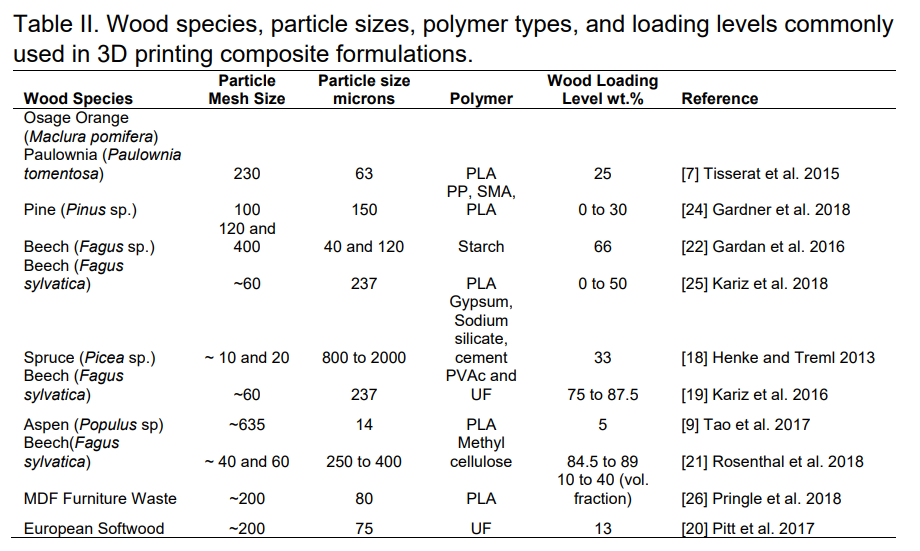In ‘Additive Manufacturing of Wood-based Materials for Composite Applications,’ authors Douglas J. Gardner and Lu Wang explore the use of wood composites, including additives such as sawdust, wood flour, lignin, and cellulose. Like composites used in many other industries, the idea behind such creations is to strengthen the initial component for greater versatility in production.
Additive manufacturing usually employed with wood compositions uses extruders, granular material bonding, and liquid deposition modeling.
Woods used in such experimentation so far include softwood, hardwood, and recycled wood, with particle sizes varying from 14 microns to 2000 microns. Common polymer types previously examined include:
- Poly-lactic acid (PLA)
- Polypropylene (PP)
- Styrene maleic anhydride (SMA) copolymer
- Polyvinyl acetate (PVAc)
- Urea-formaldehyde (UF)
- Carbohydrates (starch and methyl cellulose)

Large scale 3D printed boat roof tooling mold made from 20 wt.% wood flour and 1 wt.% CNF in a PLAmatrix [24].
“The strength properties of a printed part along the fiber’s transverse direction is often weaker than in the longitudinal direction. To improve the interlayer bond strength, fibers will need enhanced transverse strength,” stated the researchers.
The proper amount of nanofibers, combined with suitable ‘transverse integrity’ can decrease crystallinity in the matrix, allowing polymer chains near the interfacial area greater reinforcement—strengthening 3D printed layers.
“There are several disadvantages in adding fibers to polymers in 3D printing. For filament-based printers, the filament can remain flexible enough for spooling only to a certain fiber content for a given polymer. For example, a 20 wt.% fiber content was found to prevent a wood-iPP filament from properly spooling because of filament brittleness,” concluded the researchers. “Another issue related to fiber addition is the formation of porous structures inside printed beads/parts.
“Challenges in additive manufacturing with wood-based materials include processing issues during extrusion and part production, especially regarding part dimensional stability and material brittleness depending on wood component loading level as well as impacts on polymer crystallization behavior during processing. Opportunities exist for producing lighter weight and lower cost composite parts for applications in mold tooling and automobile parts.”
3D printed composites are being used more commonly today as users can more clearly define what they require when fabricating parts and prototypes. Many different composites are used to strengthen existing materials from end-of-life glass fiber composites to sintering thermoset composites, polymer nanocomposites, and more.
What do you think of this news? Let us know your thoughts! Join the discussion of this and other 3D printing topics at 3DPrintBoard.com.
[Source / Images: ‘Additive Manufacturing of Wood-based Materials for Composite Applications’]Subscribe to Our Email Newsletter
Stay up-to-date on all the latest news from the 3D printing industry and receive information and offers from third party vendors.
You May Also Like
Slice Engineering and Egyptian NGO Give Amputees Free 3D Printed Prosthetics
Florida-based Slice Engineering believes that additive manufacturing can reshape industries and make a lasting impact on humanity, and so works hard to empower innovators and professionals. The company does this...
3DPOD Episode 197: Ceramics 3D Printing with Johannes Homa, Lithoz CEO
Lithoz is a pioneer in the 3D printing of technical ceramics, initially using a ceramic-loaded stereolithography process and later adopting multiple technologies. Johannes Homa, a researcher turned entrepreneur, discusses his...
AddUp Announces Deputy CEO & Innovations in Medical & Injection Molding AM
Global metal 3D printer OEM AddUp, a joint venture between French tire giant Michelin and Paris-based industrial engineering corporation Fives, appointed Julien Marcilly as its new CEO at the end...
Lithoz Expands Ceramic 3D Printing to Japan via New Network
Lithoz is securing the future of its ceramic 3D printing technology in Japan with the formation of a new coalition with leaders from the country’s ceramics and manufacturing industries. Together...





































